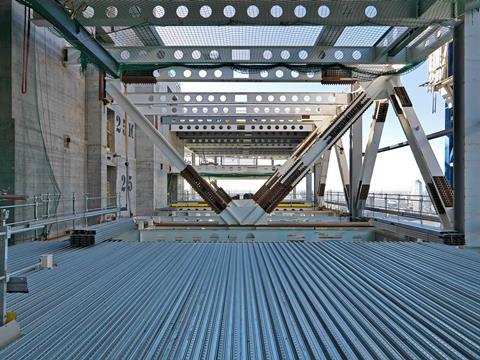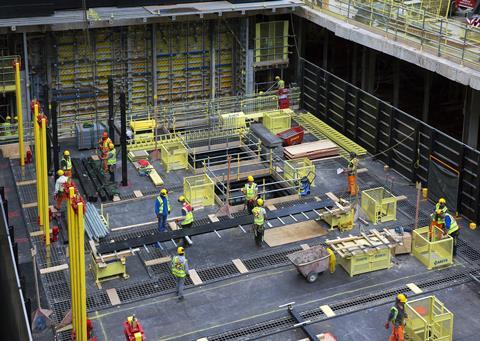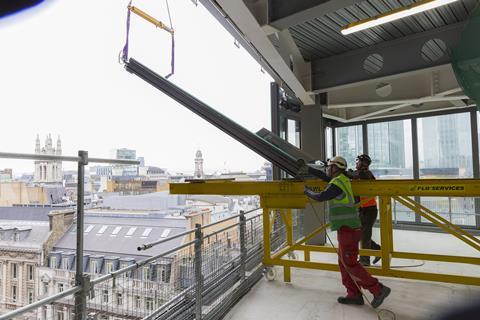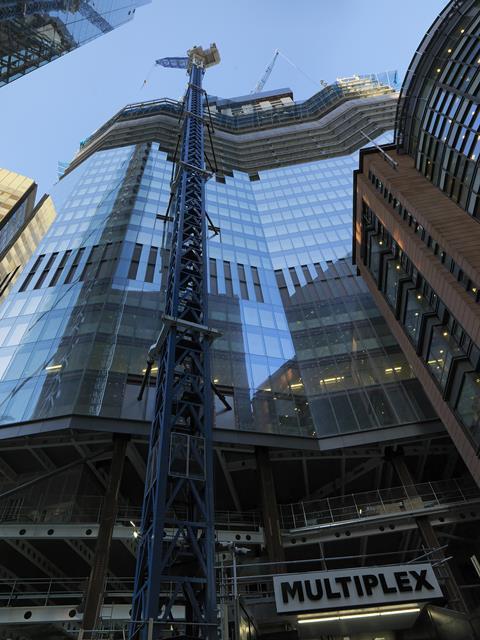22 Bishopsgate, Lipton Rogers鈥� replacement for the long-stalled Pinnacle scheme, began with the structural gymnastics of putting a massive rectangular structure on top of the remnants of the earlier building鈥檚 slender oval base. Then it got complicated


At 41 storeys up, the two jump-form rigs currently forming the giant concrete core of the 22 Bishopsgate tower are the latest addition to the City of London skyline. Already level with the tops of some of the City鈥檚 tallest buildings, the rigs still have another 20 floors to climb to complete the core of what will, at 278m high, be the second-highest building in Europe, after the Shard.
Developed by Lipton Rogers, 22 Bishopsgate is being built at the heart of the City鈥檚 cluster of tall towers on the site that was to be occupied by the tapering Pinnacle tower. The Pinnacle鈥檚 construction came to an abrupt halt in the financial crisis of 2007. According to Peter Rogers, partner and co-founder of Lipton Rogers, the subsequent financial austerity and puritanism that followed the crash meant the market no longer wanted such corporate ostentation, a criticism that cannot be levied at its replacement.
Now marketed simply as Twentytwo, the giant tower is far more restrained than that of its slender predecessor, the Pinnacle, and its smaller, more flamboyant City neighbours including the Gherkin and the Cheesegrater. 鈥淏ecause of the financial crash, we took the view that no one wanted iconic buildings so this scheme is about getting a classic American-style, big floorplate building into the City of London,鈥� says Rogers.
To make 22 Bishopsgate stack up commercially, Lipton Rogers worked with PLP Architecture and engineers WSP to push the building鈥檚 floorplates to the limits of the site boundary and in so doing succeeded in squeezing 30% more lettable floorspace onto the constrained site. 鈥淲e鈥檝e pushed the building out to the absolute boundaries of the property line; there is even a little bit of over-sailing of the street here and there,鈥� says Rogers.
In addition to its huge, 87.5m x 38.8m floorplates, the tower has been given additional commercial appeal by a lift strategy developed to enable occupants to board a lift on the ground floor and to ascend to any office floor without the need to transfer. This means that the building鈥檚 14m wide, 50m long concrete core has had to incorporate 35 lift shafts at ground floor level. 鈥淲e鈥檝e ended up with a humungous rectangular central core,鈥� Rogers says.

22 Bishopsgate is being built by Multiplex. The same hard-nosed commercial ethos that was behind the tower鈥檚 design is also applied to its construction. 鈥淭he contract is effectively CM at the front end and then a lump sum,鈥� says Rogers. It is an arrangement that has enabled the team to use specialist contractor expertise from the outset to rationalise elements of the design to ensure the most cost-effective construction solution is adopted. 鈥淎lmost before we鈥檇 won the job we went out to buy all of the major packages with Multiplex to get them [the specialist suppliers] to engineer the job,鈥� explains Rogers.
To speed the build and to minimise costs 22 Bishopsgate has been designed to incorporate virtually all of the existing below-ground structure built to support the Pinnacle; this includes three levels of basement and a raft slab supported on over 70 piles which extend up to 50m into the ground. 鈥淩ipping out the Pinnacle鈥檚 big piles and raft would have been a humungous job, which was not worth doing,鈥� says Rogers.
The challenge for engineer WSP is to stand the giant 22 Bishopgate structure on top of the subterranean remnants of the the Pinnacle鈥檚 slender oval base. Rogers outlines the task: 鈥淚f you take a piece of paper, draw an oval in the centre, dot the oval randomly with a pen to represent the existing piles, then put a larger building with a regular column grid above, that is what we鈥檙e dealing with 鈥� it鈥檚 bloody complicated in parts with some quite interesting structural gymnastics,鈥� he says.

Piling on the piles
The gymnastic routine was developed by Ross Harvey, technical director for structures at WSP. His structural solution uses every pile already in the ground 鈥� not only the 70-odd piles installed to support the Pinnacle but also the under-reamed piles that remained buried beneath the site from the Pinnacle鈥檚 predecessor, 38 Bishopsgate. However, even using all the existing piles, the scale of the new building meant that some additional piles had to be installed together with a series of 13 transfer beams to shift the loads from the huge building to where they can be dealt with effectively in the ground.
In May 2015, while the design was being finalised, construction commenced with demolition of the Pinnacle鈥檚 nine-storey concrete core, disparagingly known as the Stump, and the only element of its superstructure to have been built. The Stump鈥檚 demolition created an opening through the ground floor slab and down to the basement raft. Supported on the existing piles and existing raft slab, this newly created opening allowed the northern jump-form rig to be assembled and to start its journey upwards. 鈥淭he large cut-out enabled us to build a new blue-sky core going up,鈥� explains Harvey.

Jump leaders
The jump-form rigs being used on 22 Bishopsgate are a Multiplex design, developed on its projects in the Middle East. The double-height rigs are fully enclosed and are formed of pre-assembled elements including the two platforms attached by a series of braced steel columns. On the upper deck are a series of electronic screw jacks and the concrete placing boom along with space for rebar storage. Almost all the work takes place with operatives working in the sheltered environment of the lower deck.
The jump sequence is:
- Vertical rebar for the core is installed through slots in the top deck
- Horizontal rebar is then installed by operatives working on lower deck
- The outer shutters (which are suspended from the top deck) are rolled into position so that concrete can be poured from above
- When the concrete has cured, the outer shutters are rolled back
- The jacks then raise the rig about 30mm to allow supporting pins, which pass through the core to be removed
- Jacks raise the rig and supporting pins are slotted back into holes cast higher up the core to support rig from the core on again and the process begins all over again鈥�

Jump-form rigs
Concrete contractor Carey is constructing the building鈥檚 giant core using two jump-form rigs, one forming the core鈥檚 northern half, the other its southern half.
Launching the southern jump-form rig was less straightforward because there were insufficient existing piles to carry the load imposed by core. To drive construction forward, rather than wait for the piles to be installed, Multiplex launched the southern jump-form rig from the Pinnacle鈥檚 ground floor slab.
With the southern jump-form racing skywards, the race was on for Multiplex to install the piles and construct additional walls to support the core beneath the slab. 鈥淚n collaboration with Multiplex, we worked out that the best way of building this half of the core was to use top-down construction so that we can do the piling at the same time as the southern half of the core is being constructed,鈥� explains Harvey.
To install the new piles, part of the Pinnacle鈥檚 raft foundation had to be cut away and the upper level basement slab removed to enable 85 additional 1m diameter piles to be driven into the ground using a Martello-rig, capable of operating in the restricted headroom in the basement. 鈥淲e worked out where we needed to put in additional piles to enhance the existing [ones] because the new core is quite a lot longer,鈥� Harvey explains.
The southern rig is leading the two jump-form rigs skywards. 鈥淲e used jump-form [as opposed to slip-form] for speed, safety and security and to control quality,鈥� says David Miller, Multiplex鈥檚 construction director. The rigs are impressive; designed by Multiplex, they are fully enclosed, self-propelled workspaces, like two mini concrete factories rising into the sky. 鈥淭he jump-forms are effectively standalone; the only lifting needed is reinforcement, so crane dependency is minimal,鈥� says Miller (see Jump Leaders, previous page).
Having the same jump-form system on the two cores has allowed concrete contractor Carey to migrate operatives between the two to maximise efficiency: when the reinforcement team is working on the southern rig the shuttering team will be at work on the northern rig. When the tasks are finished the teams swap. The jump-form cycle is a floor each week, with the jumps staggered by three days between the rigs to allow the teams to alternate.

WSP had calculated that the ground floor slab from which the southern core had been launched would be capable of supporting the load from the new core on its five existing columns until the core had reached level 15. By that time Multiplex had to have constructed additional basement walls to ensure the core鈥檚 stability before it could continue its upward journey. By the time the rig reached level 20 all the new piles had been installed and a new section of the raft slab cast to spread the load over more piles. 鈥淥ur biggest challenge was to wrap in the construction methodology and timeframe of when things needed to be built into our calculations so that we can calculate the load paths for the temporary conditions,鈥� explains Harvey.
In addition to the downward loads, because the core is so slender on its east-west axis it requires additional structural support to keep it stable in high winds. This is provided by a series of three outriggers formed from giant storey-high trusses that link the concrete core to the steel structural columns that ring the building鈥檚 perimeter. Rogers explains the function of the outriggers using the analogy of an old person, arms outstretched, with a walking stick in each hand. 鈥淚t鈥檚 a very efficient structure with a steel weight of just 85kg/m2,鈥� he says, ever the developer.
The outriggers are installed on building鈥檚 two intermediate, double-height plant floors; the outriggers on level 25 are already in place, while those on level 41 will be installed later in the build. WSP had to work with steelwork contractor Severfield to agree the best way to divide up the giant trusses into sections small enough to be lifted by the tower crane while ensuring the connection points between were not put under excessive strain. 鈥淭wenty meganewtons will run through the trusses under full wind load, equivalent to supporting five fully loaded A380 Super-jumbo aircraft,鈥� says Harvey.
Chasing the jump-forms skywards is steelwork contractor Severfield. Its task is to install the steel perimeter columns and the cellular beams to link them to the core. At the lower levels the perimeter columns are inclined to take the structure from the foundations, which do not extend to the site boundary, outward to the edge of the structure and then vertically upwards. 鈥淏etween basement and level 7, we took all of the oddities out of the floorplates,鈥� says Rogers.

WSP鈥檚 Harvey explains: 鈥淭here are five different steel transfer structures within the superstructure and 13 concrete or steel transfer structures in basement,鈥� he says.
Severfield鈥檚 team are currently installing steelwork on level 36, five floors behind the jump-form, but the steelwork is being installed a faster rate than the core is being jumped so, if all goes to programme, the steelwork will catch up with the jump-form just at the point the jump-form reaches the top of the tower. Following behind the steelwork is a procession of different trades: two floors down and the ribbed steel decking is being clattered into place. Four floors down and the decking is being concreted to form the floors.
Five floors further below the concreting crew and cladding contractor Gartner (part of the Permasteelisa Group) is fitting the cladding to make the floors weathertight. The facade is a triple glazed curtain-wall system, comprising a sealed double-glazed unit and a single glazed outer-panel, with air circulated between the two panels.
Once the cladding is in place, two levels behind the procession of fit-out trades has already begun with MEP first fix. As the fit-out picks up pace Multiplex will soon have trades working on each of the next 17 floors. Each floor has a 20-week fit-out from first fix MEP to completion and locked doors. The programme is based on fit-out of one floor every week, so ever week the procession jumps up a floor fit-out begins again.
If all goes to plan, London鈥檚 latest and most restrained landmark will open in July 2019.
Project Team
Developer: AXA IM - Real Assets and Lipton Rogers Developments
Engineer: WSP
Architect: PLP Architecture
Contractor: Multiplex
Cost consultant: Alinea
Employer鈥檚 agent: Aecom























No comments yet